Heaven and hell
WAKHAN CORRIDOR, Afghanistan -- My heart sank as the soldier pressed the button on my camera, deleting the photos inside. Now I would have to return home completely empty-handed. If I would make it out at all, for I was not at all sure of the soldiers’ intentions.
I had been stuck at this small settlement in Pakistan’s northernmost corner for three days. I had grand plans -- to hike to one of the most remote places on earth, the Wakhan Corridor, a forbidding valley fenced in by some of the world’s highest mountain ranges. It had captured my imagination since childhood and after much lobbying and planning, my bosses finally allowed me to go on the trip.
When I got here, the last human encampment before the brutal hike up to the Corridor that was once part of the ancient Silk Road trade route, I was stopped by the soldiers manning a checkpoint here. They needed to verify my identity with their superiors in the city of Gilgit (where I had already been relentlessly questioned about my identity by Pakistan’s various intelligence agencies). But their communication equipment wasn’t working, so I was stuck.
 (AFP Graphics)
(AFP Graphics)As I whiled the time away, I interviewed a group of Kyrgyz traders whom I knew from their summer trips to Hunza valley, where I grew up 30 kilometers to the south. If the soldiers didn’t let me go any further, I consoled myself, at least I would have a story on barter trade in the region. But now even that was going to pieces, as the soldier deleted the pictures I took for that article.
I thought about protesting, but then decided against it -- these were Pakistani soldiers in a remote border post, where photography is not allowed. They had taken everything out of my backpack and laid the contents on a table, photographing them -- my shoes, socks, underwear, cigarettes. God only knew what they were planning for me. I was scared and mentally prepared for anything.
So imagine my surprise when the soldier in charge handed me back my now-empty camera. “You can’t take pictures here. But you can take all you want in Wakhan.” My heart leaped...
...And then came the catch.
Although I knew the way and had all the provisions I needed, the soldiers told me I couldn’t go alone, I needed to find a guide among the local traders. Which would present a challenge considering the weather.
Earlier in the day dark clouds wrapped around the Irshad Pass, at 16,300 feet (4,968 meters) the gateway to Wakhan, and snow began to fall. The locals consider an October snowfall a bad omen because most of the deadly accidents on the pass have happened in October. That group of Kyrgyz traders whom I interviewed had left the previous day and the traders were guessing at which place they would be hit by an avalanche in the same casual manner that men elsewhere would discuss which player of a football team would score at which point in the match.
 The bleak way to Irshad Pass in an October snowfall. (Photo courtesy of Gohar Abbas.)
The bleak way to Irshad Pass in an October snowfall. (Photo courtesy of Gohar Abbas.)“Drop it, it’s stupid to go now, it’s an October snowfall,” the traders told me when I asked them to go with me. Finally I found one who was a distant relative of my wife and who agreed to come along for 300 dollars.
Snow was falling and the traders shook their heads as we took off for Irshad -- me, the trader Afzal Baig, and a horse carrying our provisions. After years of imagination and months of lobbying, I was finally on my way.
I had dreamed of seeing Wakhan ever since I was a little kid, growing up in Hunza valley, in northern Pakistan.
My father and grandfather would tell me: “it is where we come from,” and my imagination would fly to the narrow valley jutting out of Afghanistan’s northeastern edge.
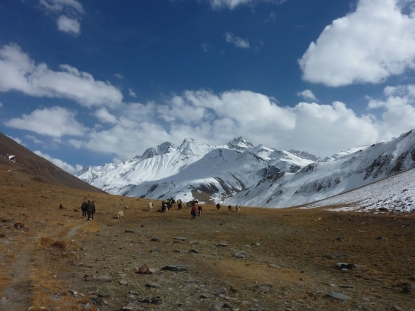 Stuff childhood dreams are made of -- the Wakhan corridor. (Photo courtesy of Gohar Abbas)
Stuff childhood dreams are made of -- the Wakhan corridor. (Photo courtesy of Gohar Abbas)But imagine was all I could do -- the Wakhan Corridor is one of the most remote places in the world, bordered by three of Asia’s highest mountain ranges -- the Hindu Kush, the Karakoram and the Pamir. It is so distant that you can only reach it during a few months in the year, when snow has melted from the passes that guard the way in; it is so remote that most people living there have never even heard of the Taliban, a key player in their country for more than 20 years.
Ancestors of all Wakhi people, like me, once came from this inhospitable land that today is home to some 12,000 souls. So whenever I heard about the mythical Wakhan Corridor, I always wondered what it was like.
Part of the pull was because, as a Wakhi, I am a minority in Pakistan, the country where I was born and grew up, and I often cannot relate to the people and the customs around me -- from interactions with women to the drinking of alcohol.
When I was a child, I didn’t feel the difference that much because everyone in Hunza and the surrounding towns are Wakhis, a people scattered around the Pamir Mountains in Tajikistan, Afghanistan, China and Pakistan. Everyone spoke Wakhi, everyone practiced the Ismaili version of Islam.
But once I went to college in Karachi, the differences were hard to miss. At home, boys and girls studied together (according to our tradition, if you have a boy and a girl and only enough money to educate one of them, educate the girl), the girls didn’t have to cover their hair, women and men prayed together in prayer halls, there were no muezzin calls to prayer, and we would drink homemade alcohol.
But now the muezzin woke me up in the morning, there were no girls in my classes, the ones on the street had their hair covered, I could only pray with men in mosques, alcohol was strictly forbidden. I felt like I was in a different country.
So I longed to see the Wakhan Corridor, where I felt I would belong. As a child, I would see traders from Wakhan all the time -- they would come down to Hunza when the pass was open to trade their yaks and sheep for food and whatever else they needed.
Families like mine would always buy something from them because we all knew they were poor and we wanted to help. A yak bought from the traders would be slaughtered in October and the meat would last an extended family of around 15 until March.
 Yaks grazing in Wakhan; eventually they will be bartered for good and food.
(AFP / Gohar Abbas)
Yaks grazing in Wakhan; eventually they will be bartered for good and food.
(AFP / Gohar Abbas)When I became a journalist after college in Karachi, professional interest added to personal curiosity -- Wakhan was such a remote part of Afghanistan and so different from the parts that the outside world usually heard about, it was a journalist’s dream to write about it.
My quest to get there seemed to get a boost in 2016, when I was visiting family in Hunza and traders told me that there were Chinese troops in Wakhan. That was my way in -- a genuine news angle. But when I suggested it to my boss, she broke the bad news to me -- since AFP had a bureau in Kabul, they had first dibs on writing about something in Afghanistan.
Luckily for me, the security situation in the surrounding area meant that our Kabul team couldn’t get to Wakhan from the Afghanistan side. My bosses in Islamabad were also concerned about security and safety, as the way to Wakhan was so treacherous, but I reassured them: “I know the area, I am Wakhi, I speak the language, I will get there without any problems,” I told them. “It will make for a great story.” Eventually all office logistics were worked out and I got the go-ahead, but it was November -- the Irshad Pass was closed, so I would have to wait until it opened again the following summer.
In 2017, the pass opened a month later because of heavy snowfall and avalanche danger. So I set out on my journey at the end of September. I thought I’d be gone for two weeks.
As Afzal Baig and I started our trek toward Irshad, the snow got heavier and heavier with each step, so we had to camp for the night at the base of the pass. We woke up at five in the morning. The snow showed no signs of slowing down as we started our uphill climb to Irshad.
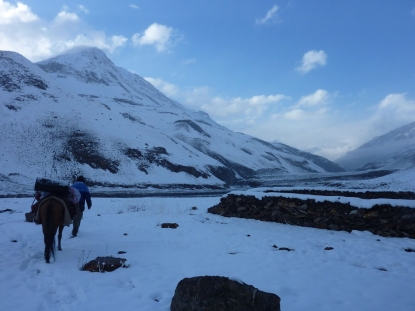 Trader Afzal Baig leads the way on the trek to Wakhan. (Photo courtesy of Gohar Abbas)
Trader Afzal Baig leads the way on the trek to Wakhan. (Photo courtesy of Gohar Abbas)Afzal took the lead, followed by his horse, and I was at the back. You could only see a few steps in front of you and the melting snow on my sunglasses was making matters even worse. But at heights like that, snowblidness is a very real and painful possibility, so you keep your glasses on.
 The author trying to see more than a few feet in front of him during the trek to Wakhan. (Photo courtesy of Gohar Abbas)
The author trying to see more than a few feet in front of him during the trek to Wakhan. (Photo courtesy of Gohar Abbas)We were way behind schedule and only reached the top of Irshad at nightfall. There was no safe place for us to spend the night, so we had no choice but to start our descent on the steep slopes of the other side in the dark. I was acutely aware of the traders’ warnings of the curse of an October snowfall with each step.
We climbed down for another eight to nine hours in the dark until we found a place that we felt was safe from avalanche danger. We set up our tent, but the relentlessly-falling snow kept collapsing it, so we decided to sleep in turns -- one would sleep while the other looked after the tent.
 Trying to keep warm in the tent. (Photo courtesy of Gohar Abbas)
Trying to keep warm in the tent. (Photo courtesy of Gohar Abbas)The next day we walked for almost fifteen hours, taking two short breaks -- one for noodles and one for cigarettes. I cursed the shopkeeper in Islamabad who sold me a parka and boots made in China -- both were supposed to be waterproof and both were completely drenched, leaving me shivering in the cold.
The second night, I tried to dry my shoes and socks in the fire and ended up burning both. So the morning after I started out on our trek wearing plastic bags for socks to try to avoid the water seeping through my burnt boots. It was in that sorry state that we finally reached the Wakhan corridor. “I am home,” I thought to myself as a few locals came toward us, and the hardship of the journey melted away like a bad dream.
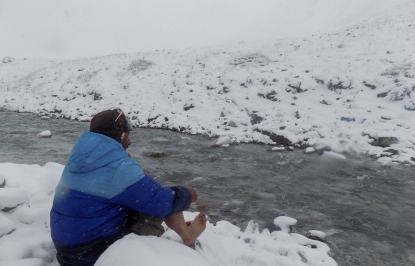 Trader Afzal Baig gets ready to cross a stream. (AFP / Gohar Abbas)
Trader Afzal Baig gets ready to cross a stream. (AFP / Gohar Abbas) The author trying to keep warm with hot noodles. (Photo courtesy of Gohar Abbas)
The author trying to keep warm with hot noodles. (Photo courtesy of Gohar Abbas)
Four women came toward us. At first we shook hands and they were formal, but as soon as I started speaking Wakhi and they realized I was one of them, they kissed me on the hand and surrounded me, pepering me with questions. “How are the people on the other side, what is happening, how are your parents, have you brought us plastic buttons?”
While the Wakhan men leave to go on trading missions in the summer, the women spend their entire lives here. So a stranger showing up, even a semi-Wakhi-stranger like me, is a celebration in an otherwise harsh and monotonous existence. I would spend hours talking to them about anything and everything -- people travelling in cars, food cooked in machines or without using a fire (not using a fire to cook something is a complete mystery to them). Make-up is non-existent there, but the women use buttons as decorations and occasionally will buy jewelry from passing traders.
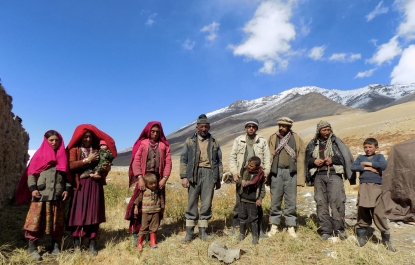 A Wakhi family poses for a family portrait in the Wakhan Corridor. (AFP / Gohar Abbas)
A Wakhi family poses for a family portrait in the Wakhan Corridor. (AFP / Gohar Abbas)With no link to the outside world, Wakhan is like heaven and hell mixed up in one. The scenery is intoxicating -- the snow-capped mountains all around, the red grass, the hundreds of yaks, the silence. But as beautiful as the surroundings are, as hard life is in a place where it is below freezing for more than 300 days a year.
The houses -- usually made of mud or yurts -- are spaced far apart from each other -- about three kilometers -- and each house has land the size of a small village. That makes it easier to keep one’s cattle -- and each household has several heads of yaks, goats and sheep -- separate from the others.
There is no money and everyone lives by barter -- three warm hats equal one sheep, 10 kilos of tea or five kilos of flour are worth a yak. In the summer, the men will leave the corridor to barter the cattle in places like my hometown and stock up on essentials -- food, clothes. In the winter the men take their cattle to graze during the day and come back home when the sun goes down. The women take care of the house.
As you can imagine, in this environment none of the locals have an abundance of anything except fresh air. But their hospitality is overwhelming. They will offer you endless cups of tea and the best food they have, even though everything they give to you takes away from their provisions. Guests may be rare, but they get the best food (they actually get tourists every once in a while -- when I was there, there was an Italian lady with a Wakhi guide and a few weeks before that, a National Geographic crew visited.)
Noone knows how old they are. People don’t say a year when they were born. They say things like “when he was born, two of our yaks died” or “there was heavy snowfall.”
 Sultan Begium (L) and her daughter-in-law prepare food inside their mud home. (AFP / Gohar Abbas)
Sultan Begium (L) and her daughter-in-law prepare food inside their mud home. (AFP / Gohar Abbas)Neither are there names for places leading to the corridor. Rather, they are referred to, darkly, as places where accidents have happened. So people will say “this is where Karim had an accident,” or “This is where Khan died.”
There is no robbery, no crime and no police. The environment is so harsh, it is impossible to survive alone, without the help of others. So the people have no choice but to get along. The most severe crime that I was told about is a harsh word in an argument, usually over a yak grazing in someone else’s territory. So when someone tells you that he “had a war” with someone else, it means a heated debate. Which is remarkable considering how war has engulfed every other part of Afghanistan for the past 40 years. Here, noone knows who the Taliban are. The only thing they know of the Soviet Union’s invasion of Afghanistan in 1979 and the mujahideen fightback is that there was a time when Russian soldiers had given out cigarettes on the other end of the Corridor.
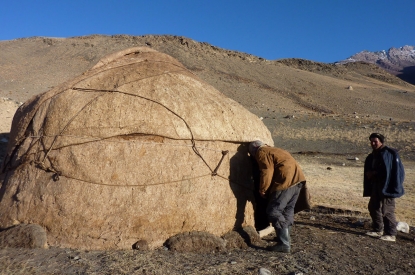 An ethnic Kyrgyz boy enters his yurt in the Wakhan Corridor. Along with the Wakhis, there are ethnic Kyrgyz who live in the inhospitable landscape.
(AFP / Gohar Abbas)
An ethnic Kyrgyz boy enters his yurt in the Wakhan Corridor. Along with the Wakhis, there are ethnic Kyrgyz who live in the inhospitable landscape.
(AFP / Gohar Abbas)There are rarely physical fights because there is so little medicine -- if you get hurt, it can be deadly, so better to avoid it alltogether.
There is no hospital, no doctor and little medicine. A large number of women die as a result of delivery complications. Children often die because of illness, including minor flu. Each death is part of life in this harsh land, but each is felt so keenly, the pain intense.
The struggle for existence means opium is a daily part of life. At the end of the day, everyone smokes it. Some use it for fun, others to forget the loss of loved ones, others because of boredom. Kids start at around nine or 10. In the end, everyone becomes an addict.
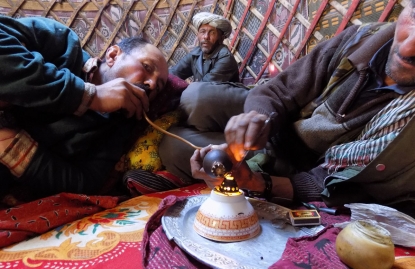 Relaxing with opium at the end of a day.
(AFP / Gohar Abbas)
Relaxing with opium at the end of a day.
(AFP / Gohar Abbas)When I left, I had a delicious feeling of satisfaction. I had finally fulfilled my dream and visited this place that had captured my imagination since childhood. My planned two weeks away had turned to four, but it was well worth it (and the Kyrgyz traders who left before me made it as well). We went back with some traders from Hunza who had come up to the corridor before us. The way back was as harsh as the way in, but seemed easier since there were now 18 of us instead of two.
But there was also tremendous sadness, for reality didn’t quite live up to the imagination of my childhood. The poverty and the backwardness I saw were beyond anything I had imagined. The mud houses, the dirty, torn clothes. Every time I would throw away an empty pack of cigarettes, people would pick it up and give it to a child to play with.
This is the hellish side of the Wakhan Corridor, one that stands in such stark contrast to the hospitable people surviving there and to the natural beauty that’s as narcotic as the opium that eases the harshness of life.
This blog was written with Yana Dlugy in Paris.
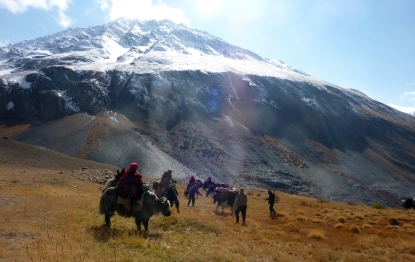 (AFP / Gohar Abbas)
(AFP / Gohar Abbas)


